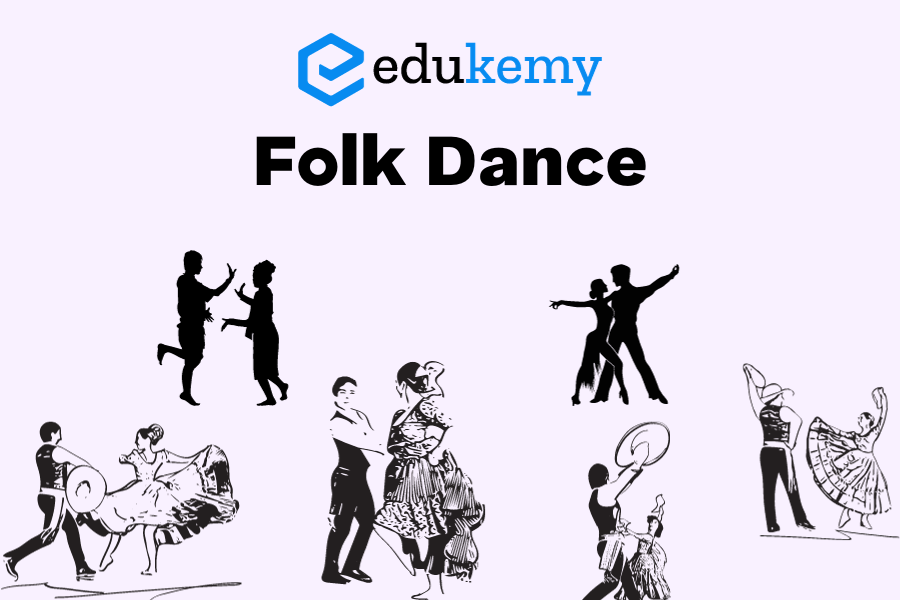
Folk dance are a testament to traditions, and stories, and a celebration of the everyday lives of people across various regions. Unlike classical dances that often require rigorous training and follow prescribed rules, folk dances are spontaneous expressions of joy, sorrow, and daily routines. They are a reflection of the soul of India’s diverse cultural terrain.
Each state or region in India boasts its unique folk dance traditions, which are a testament to the rich history and cultural diversity of the country. These dances are not just artistic expressions but also serve as a living history of the communities that have practiced them for generations.
Contents
- 0.1 Chhau (Odisha):
- 0.2 Garba (Gujarat):
- 0.3 Dandiya Raas (Gujarat):
- 0.4 Tarangamel (Goa):
- 0.5 Ghoomar or Gangore (Rajasthan):
- 0.6 Matki (Madhya Pradesh):
- 0.7 Alkap (Jharkhand and West Bengal):
- 0.8 Biraha (Bihar):
- 0.9 Paika (Odisha):
- 0.10 Jat-Jatin (Bihar):
- 1 FAQs on Folk Dance
- 2 In case you still have your doubts, contact us on 9811333901.
Chhau (Odisha):
Significance: Chhau is a mask dance that narrates mythological stories through powerful martial movements.
Variants: Seraikella Chhau (Jharkhand), Mayurbhanj Chhau (Odisha), and Purulia Chhau (West Bengal).
Notable Mention: UNESCO recognized Chhau as part of the Representative List of Intangible Cultural Heritage of Humanity in 2010.
Garba (Gujarat):
Significance: Garba is a popular Gujarati folk dance performed during Navratri, symbolizing the celebration of the divine feminine.
Unique Element: Dancers form a circle around a lit earthenware pot (Garbha deep) and engage in rhythmic clapping.
Dandiya Raas (Gujarat):
Significance: This dynamic dance depicts a fictitious battle between Goddess Durga and the demon Mahishasura.
Props: Dancers use polished sticks called dandiyas in this vibrant performance.
Tarangamel (Goa):
Significance: Tarangamel celebrates the youthfulness of Goa and is performed during Hindu festivals like Dussehra and Holi.
Visual: The dance is a visual spectacle with rainbow-like outfits, multi-colored banners, and streamers.
Ghoomar or Gangore (Rajasthan):
Significance: Ghoomar is a traditional Rajasthani folk dance performed by women of the Bhil tribe, known for its graceful pirouettes.
Highlight: The dance showcases the vibrant colors of the traditional Ghagra (skirt).
Matki (Madhya Pradesh):
Significance: Matki is a traditional dance performed by women in the Malwa region during weddings and celebrations.
Unique Element: Dancers balance multiple earthen pots on their heads, often performing solo.
Alkap (Jharkhand and West Bengal):
Significance: Alkap is a group dance that combines storytelling and comedy, often performed during Shiva’s Gajan festival.
Highlight: The performance includes popular folklore and mythical stories with comedic sketches known as kap.

Biraha (Bihar):
Significance: Biraha portrays the anguish of women separated from their partners and is unique as it’s performed by men who play feminine characters.
Paika (Odisha):
Significance: Paika is a martial folk dance from Odisha’s southern regions, featuring long spear-like props and army formations. The name “Paika” itself translates to “war.”
Jat-Jatin (Bihar):
Significance: Jat-Jatin, prevalent in Bihar’s northwestern regions, showcases the sensitive love and disputes of a married couple.These folk dances resonate with the history, culture, and emotions of the communities that have preserved them for centuries. In a country as vast and culturally rich as India, folk dances are more than just performances; they are an integral part of the nation’s identity and a testament to its cultural wealth. They remind us that India’s heart beats to the rhythm of countless stories, emotions, and traditions, all beautifully expressed through the art of dance.
FAQs on Folk Dance
1. What is folk dance?
A: Folk dance refers to traditional dances that have evolved within a particular community, ethnic group, or region. These dances are passed down through generations and often reflect the cultural identity and history of the community.
2. How are folk dances different from other dance forms?
A: Unlike formal dance styles, folk dances are typically not choreographed by professional dancers. They emerge organically from the daily lives, rituals, and celebrations of a community. Folk dances are often characterized by simple steps and movements that can be easily taught and passed down to the next generation.
3. What role do folk dances play in cultural preservation?
A: Folk dances are an essential element of cultural preservation, as they embody the traditions, values, and stories of a community. Through these dances, cultural practices are passed on to younger generations, helping to maintain a sense of identity and continuity within a society.
4. How do folk dances vary across different regions?
A: Folk dances exhibit significant regional diversity, with each community expressing its unique cultural elements through dance. Variations can include differences in costumes, music, choreography, and the occasions for which the dances are performed. The diversity reflects the rich tapestry of human culture and history.
5. Can anyone participate in folk dances, or are they exclusive to specific communities?
A: While folk dances often originate from specific cultural groups, many are open to participation by people from diverse backgrounds. In contemporary settings, folk dances are sometimes adapted for wider audiences, serving as a means of cultural exchange and fostering a sense of unity among people from different communities. However, respectful awareness of the cultural context is important to ensure the dances are performed with sensitivity and authenticity.
In case you still have your doubts, contact us on 9811333901.
For UPSC Prelims Resources, Click here
For Daily Updates and Study Material:
Join our Telegram Channel – Edukemy for IAS
- 1. Learn through Videos – here
- 2. Be Exam Ready by Practicing Daily MCQs – here
- 3. Daily Newsletter – Get all your Current Affairs Covered – here
- 4. Mains Answer Writing Practice – here

